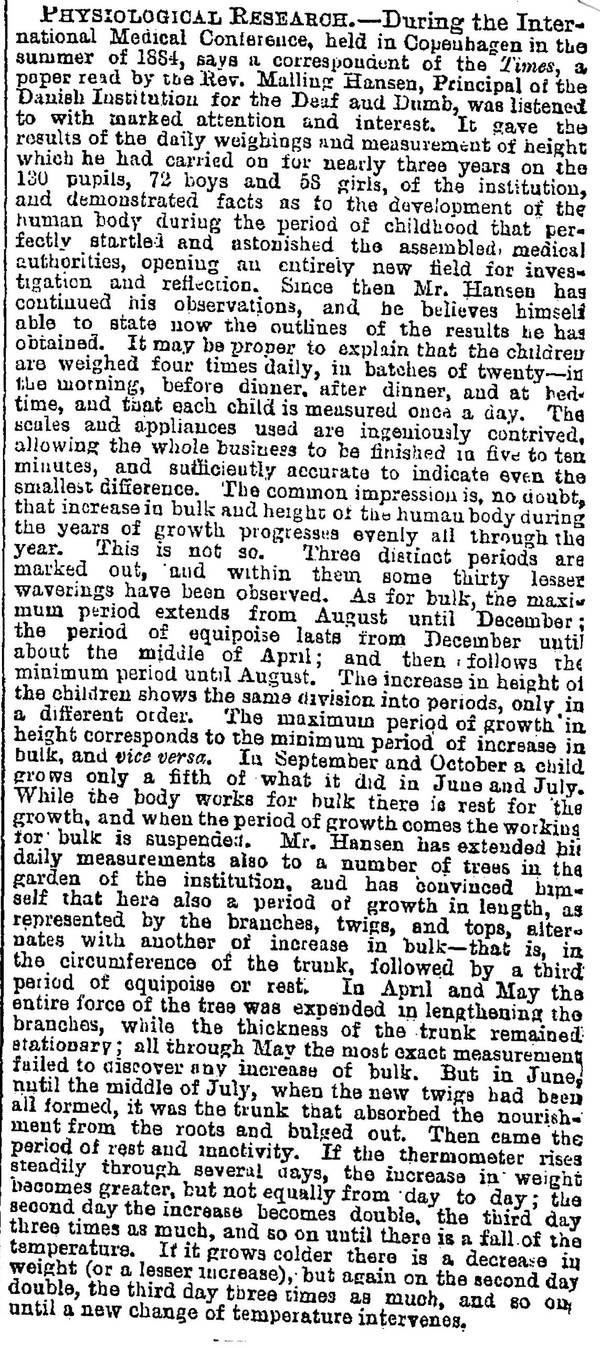Leeds Mercury, Saturday, January 9, 1886, No 14900
Transcription by Jørgen Malling Christensen
Article on PHYSIOLOGICAL RESEARCH[1].
During the International Medical Conference, held in Copenhagen in the summer of 1884, says a correspondent of the Times, a paper read by the Rev.Malling Hansen, Principal of the Danish Institution for the Deaf and Dumb, was listened to with marked attention and interest. It gave the results of the daily weighings and measurement of height which he had carried on for nearly three years on the 130 pupils, 72 boys and 58 girls of the institution, and demonstrated facts as to the development of the human body during the period of childhood that perfectly startled and astonished the assembled medical authorities, opening an entirely new field for investigation and reflection. Since then Mr.Hansen has continued his observations, and he believes himself able to state now the outlines of the results he has obtained. It may be proper to explain that the children are weighed four times daily, in batches of twenty – in the morning, before dinner, after dinner, and at bedtime, and that each child is measured once a day. The scales and appliances used are ingeniously contrived, allowing the whole business to be finished in five to ten minutes, and sufficiently accurate to indicate even the smallest difference. The common impression is, no doubt, that increase in bulk and height of the human body during the years of growth progresses evenly all through the year. This is not so. Three distinct periods are marked out, and within them some thirty lesser waverings[2] have been observed. As for bulk, the maximum period extends from August until December; the period of equipoise lasts from December until about the middle of April; and then follows the minimum period until August. The increase in height of the children shows the same division into periods, only in a different order. The maximum period of growth in height corresponds to the minimum period of increase in bulk, and vice versa. In September and October a child grows only a fifth of what it did in June and July. While the body works for bulk there is rest for the growth, and when the period of growth comes the working for bulk is suspended. Mr Hansen has extended his daily measurements also to a number of trees in the garden of the institution, and has convinced himself that here also a period of growth in length, as represented by the branches, twigs and tops, alternates with another of increase in bulk – that is, in the circumference of the trunk, followed by a third period of equipoise or rest. In April and May the entire force of the tree was expended in lengthening the branches, while the thickness of the trunk remained stationary; all through May the most exact measurement failed to discover any increase of bulk. But in June, until the middle of July, when the new twigs has been all formed, it was the trunk that absorbed the nourishment from the roots and bulged out. Then came the period of rest and inactivity. If the thermometer rises steadily through several days, the increase in weight becomes greater, but not equally from day to day; the second day the increase becomes double, the third day three times as much, and so on until there is a fall of the temperature. If it grows colder there is a decrease in weight (or a lesser increase), but again on the second day double, the third day three times as much, and so on, until a new change of temperature intervenes.
[1] JMC: This is a short article, but even so the journalist has succeeded very well in explaining, in layman terms, the gist of RMH’s research findings.
[2] JMC: The word “wavering” is, in my understanding, a particularly relevant and exact translation of the minor periods of variations/oscillations in height and weight.


